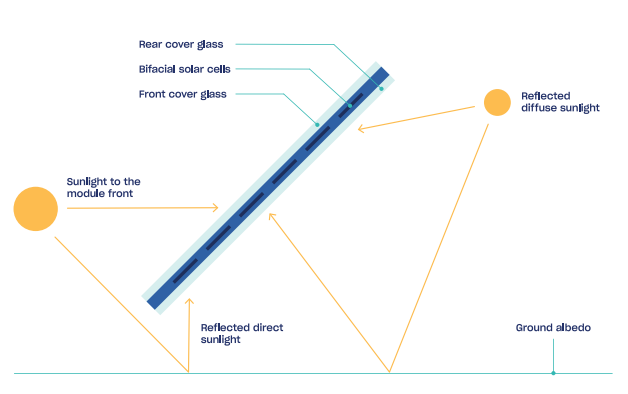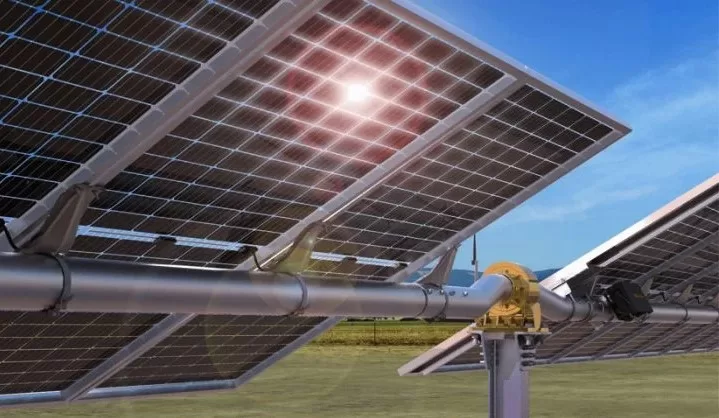Renewable energy is increasingly being recognized as a vital component of a sustainable future. Solar power has grown recently due to technological advancements and lower costs. Bifacial solar panels, which capture energy from both sides, are one such innovation that improves efficiency and performance.
Introduction
Bifacial solar panels, as the name suggests, are solar panels that can generate electricity from both sides. Unlike traditional solar panels, which only use the front side to capture sunlight, bifacial solar panels have a transparent backsheet that allows them to also absorb light from the back. This means that they can generate more energy than traditional solar panels, making them a more efficient and cost-effective option.
These panels existed for decades, but only recently gained attention and adoption. Technological advancements made them more affordable and easier to produce, while awareness of their benefits increased.
One of the main advantages of using bifacial solar panels is their increased efficiency. By capturing energy from both sides, they can generate up to 30% more electricity than traditional solar panels. This not only makes them more cost-effective but also reduces the amount of land needed for solar farms, making them a more environmentally friendly option.

How Bifacial Solar Panels Work
Bifacial solar panels work differently from traditional solar panels in several ways. The main difference is that they have a transparent backsheet, which allows them to capture light from both sides.
Manufacturers usually construct the backsheet from glass or plastic materials and coat it with an anti-reflective layer to minimize light loss due to reflection.
Sunlight absorbed by the photovoltaic cells on the front side of the panel converts into electricity. Some light also reflects back to the backsheet, where cells on the other side can absorb and use it. This bifaciality process enhances the panel’s total energy generation capacity.
The effectiveness of bifacial solar panels depends on albedo, which refers to the light reflection from the surface where the panel is installed. High albedo surfaces, like snow or concrete, can reflect more light onto the panel’s back, boosting its efficiency. As a result, considering the albedo of the installation site is crucial when deciding to use bifacial solar panels.
Types of Bifacial Solar Panels
There are several types of bifacial solar panels, each with its own advantages and disadvantages. The most common types are glass-glass, glass-backsheet, and back-contact solar panels.
Glass-glass solar panels are the most durable and long-lasting option, as they have a double layer of glass that provides protection from weather and other environmental factors. Glass-backsheet solar panels are more lightweight and cost-effective, but they are less durable than glass-glass panels. Back-contact solar panels, on the other hand, are the most efficient type of bifacial solar panels, but they are also the most expensive and difficult to manufacture.
When deciding which type of bifacial solar panel to use, it’s important to consider factors such as cost, durability, and efficiency, as well as the installation location and the specific energy needs of the project.
Installation and Maintenance of Bifacial Solar Panels
Installing bifacial solar panels requires some additional considerations compared to traditional solar panels. One important factor is the installation angle, which affects how much light can be captured by the backsheet. Ideally, the panels should be installed at a tilt that maximizes the amount of light that hits the backsheet.
Bifacial solar panel maintenance resembles traditional panels, needing regular cleaning and inspection. However, due to their transparent backsheet, avoid abrasive cleaning to prevent scratches and efficiency loss.

Bifacial Solar Panels vs. Traditional Solar Panels
When comparing bifacial solar panels to traditional solar panels, there are several factors to consider. One of the main advantages of these panels is their increased efficiency, which can lead to lower costs and reduced land use requirements. However, they are also more expensive to manufacture and require additional installation considerations, which can offset some of these benefits.
Another advantage of bifacial solar panels is their ability to generate energy in a wider range of conditions, such as cloudy or overcast weather. This makes them a more reliable option for regions with variable weather patterns.
Applications of Bifacial Solar Panels
Commercial and utility-scale solar projects frequently use bifacial solar panels, as their enhanced efficiency and performance can lead to substantial cost savings. Their versatility and reliability also make them suitable for residential and off-grid applications, where they serve as a practical option for clean energy generation.
Bifacial solar panels find uses in innovative applications as well. For instance, integrating them into building facades or shading structures offers both energy generation and aesthetic advantages.
Challenges and Future of Bifacial Solar Panels
Like any technology, bifacial solar panels face several challenges and limitations. One of the main challenges is their cost, which can be prohibitively high for some applications. Additionally, they require specialized installation and maintenance, which can add to the overall cost.
However, despite these challenges, the future of bifacial solar panels looks promising. Continued advancements in technology and manufacturing are expected to reduce costs and increase efficiency, making them a more accessible option for a wider range of applications. Additionally, the increasing demand for clean energy and the growing awareness of the importance of sustainability are driving interest in renewable energy solutions like bifacial solar panels.
Looking ahead, the potential for bifacial solar panels to revolutionize the renewable energy industry is significant. The increased efficiency and versatility of bifacial solar panels make them a practical and cost-effective choice for clean energy generation. As technology improves, experts anticipate their adoption will grow.
Conclusion
Bifacial solar panels offer a unique and innovative solution for generating clean energy. Capturing energy from both sides, bifacial panels offer higher efficiency and performance than traditional panels, making them cost-effective and eco-friendly. Despite challenges, their future is promising for a sustainable transition.
FAQs
What is the future of bifacial solar panels?
- With advancing technology and manufacturing, bifacial solar panels are expected to become more accessible and efficient. Their versatility and reliability make them a practical, cost-effective clean energy option, with adoption set to increase.
Are bifacial solar panels more expensive than traditional solar panels?
- Yes, they are generally more expensive to manufacture and require additional installation considerations, which can increase their overall cost.
What is albedo and why is it important for bifacial solar panels?
- Albedo refers to the amount of light that is reflected by the surface the panel is installed on. Surfaces with high albedo can reflect more light onto the back of the panel, increasing its efficiency. Therefore, it’s important to consider the albedo of the installation location when deciding whether to use bifacial solar panels.
Can bifacial solar panels generate energy in cloudy weather?
- Of course, they can generate energy in a wider range of conditions, including cloudy or overcast weather.
What are the advantages of using bifacial solar panels?
- These panels offer increased efficiency and performance compared to traditional solar panels, as well as the ability to generate energy in a wider range of conditions. They can also provide cost savings and environmental benefits.